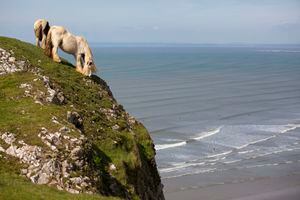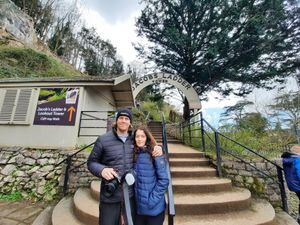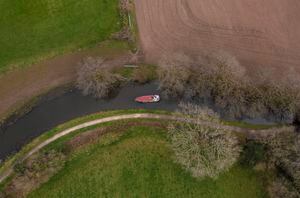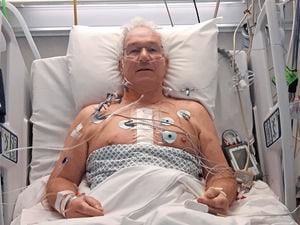Tidy times
GP picture editor Peter Frankland takes a road-trip down memory lane to his university town of Swansea

THE much acclaimed, influential and remarkable Welsh poet Dylan Thomas described Swansea as being ‘An ugly, lovely town... crawling, sprawling... by the side of a long and splendid curving shore’.
Sixty years later, the fictional corrupt police officer Terry Walsh, played by Dougray Scott in the 1997 film Twin Town, used only three words to describe our university home. In the opening scene of the much-loved film, he referred to Abertawe as a ‘pretty, shitty city’.
Twin Town was filmed in Swansea while myself and my then girlfriend Stephanie were studying there back in the 1990s and I have to say that at that time Terry Walsh’s description of the place was probably more accurate. But we loved it, of course, and when we recently returned after 25 years, we found a very different and much improved, modern Swansea....
Surprisingly, we had managed to persuade our two teenage boys to come with us on our little trip down memory lane and, as always for one of our road-trips, we started by cramming the car full of stuff that we might, might not and definitely wouldn’t need. A couple of surfboards, some fishing rods, reels and tackle, enough clothes to last six months and more electronic devices than Curry’s. But that’s the beauty of travelling by car and we all enjoy sailing more than flying – it’s far more civilised and stress-free.
We’d booked an overnight crossing with Condor Ferries on the Commodore Clipper and after dumping our clobber in our cosy cabin we grabbed a bite of surprisingly good food from the on-board restaurant (I’d thoroughly recommend the chilli con carne) before heading up to the Casquets Bar to grab a drink, play some card games and chill out. See? Civilised and stress-free.
The following morning, having had a great night’s sleep, we were raring to get going on our adventure and after a quick cooked breakfast as we approached Portsmouth, we were good to go.
It’s not a particularly long drive up to Swansea but since we had the benefit of an early start from Portsmouth, we decided to stop off in the Mendip hills and check out Cheddar Gorge on our way.
This incredible limestone chasm forms part of the Cheddar Complex, a site of special scientific interest since 1952, and winds its way through the beautiful Somerset countryside. The gorge is three miles long and nearly 400ft deep and is truly spectacular. It is home to the deep, dark and incredible Cheddar show caves, a series of giant caverns which began their formation around 500,000 years ago when rainwater began to eat away at the rock.
We parked up and headed straight for Gough’s Cave – the largest at the site and named after Richard Gough, who excavated and opened the caves to the public in the late 19th century.
It’s spectacular and carefully lit to enhance the natural beauty of the stunning rock formations. Stalactites hang from the roof high above while stalagmites creep up from the floors of the vast chambers. With names for some of these chambers such as ‘St Paul’s Cathedral’ and ‘Solomon’s Temple’ you get a good idea of what to expect.
Back outside there is a museum, more caves to explore as well as lots of pretty boutique shops and cafes dotted around the tiny village.
To get a panoramic view of the gorge and surrounding countryside, we braved the 274 steps of Jacob’s Ladder which runs up the side of the cliff face and then took on a further set of spiral stairs to the top of the lookout tower. We were exhausted after the climb and there was a fair bit of wheezing going on, but the view across the Mendip hills and gorge was worth it.
Back at ground level and in need of replacing all those calories we’d just burned; we visited the Cheddar Gorge Cheese Company – the only Cheddar made in Cheddar. This family-run business is intent on preserving the original character of their namesake and cite the environmental factors that affect the quality of their cows’ milk such as the local geography, earth and weather as reasons why their cheese is a cut above the rest. You can even watch the cheese being made at their working dairy and their ‘cave matured’ cheddar can be seen in racks inside Gough’s Cave where ‘the high humidity of the caves and environmental conditions significantly influence flavour’. We tried most of the cheeses on offer at their tasting station and made a few purchases before heading back to the car, via the edge of the winding and fast flowing water of the Cheddar Yeo.

The huge cooling towers of the giant industrial site at Port Talbot steel works were always the sight we longed for at the end of the five-and-a-half-hour National Express bus journey from Gatwick Airport while we were studying in Swansea. It signalled the end of a tedious bus journey spent staring at a large digital clock above the driver’s head, wishing the time away.
The Port Talbot skyline hasn’t changed a bit, but Swansea was a different city altogether and it was obvious as soon as we turned off the M4. The old Swansea Institute and Swansea Metropolitan University, where we studied, have now merged with the University of Wales Trinity St David and the huge campus buildings, all glossy and bright, line the seafront of Swansea Bay. My son William is already considering his university options and his eyes lit up at the sight of these modern looking facilities. Could he end up studying his chosen subject in Swansea too?
We checked in at our hotel (a Premier Inn near the shiny looking football stadium – what happened to the old league two stadium with half empty terraces, drab grey concrete and barbed wire?) and headed straight out in search of some nostalgia.
The Kingsway, one of the city centre’s key areas and the former hub of the infamous Swansea nightlife, has gone green. Where there were once four lanes of Tarmac, there are now broad pedestrian walkways alive with trees with new public areas, landscaped parkland, cycle routes and single lane vehicle access alongside wide pedestrian walkways. The dilapidated nightclubs have gone to make room for flash looking office blocks and apartments.
Around the corner we find fountains, trendy wine bars with alfresco dining and even an ingenious milkshake and ice-cream vending machine – much more impressive than it sounds.
The Swansea indoor market is one part of the city which remains the same. Its stalls are laden with wonderful looking (and smelling) fruit and vegetables, beautiful looking fresh fish, cut flowers and, of course, Welsh cakes. These traditional sweet flat breads were being baked on cast-iron griddles and dusted with caster sugar at various stalls throughout the market and brought back memories of a sweet treat during our student days.
The following day we headed to Mumbles, a small village at the end of Swansea Bay. It used to be the place all students headed to on a Saturday night where we would take on the ‘Mumbles Mile’ – one of the most popular pub crawls in Swansea, if not Wales.
The idea behind the pub crawl was simple: You walked a mile and had a drink in each pub along the way. Sounds easy enough but at one time there were 26 pubs along the stretch with the bizarre yet irresistible beach-front Cinderella’s Nightclub at the end.
Today many of those pubs have closed, been turned into restaurants or flash looking houses and the whole area has a much more upmarket family-orientated feel. The old crazy golf course remains alongside the ice-cream parlours and the beautiful promenade which leads to a Victorian pier and the obligatory slot machine arcade.
Much to our disappointment, Cinderella’s has gone too. It was the place where Stephanie and I met all those years ago but is now a building site following a fire in August 2022. We had to laugh but at the same time we couldn’t believe that we were just a few months too late after we had left it so long to re-visit. People must have thought we were mad as we got the boys to take pictures of us in front of the metal barriers and Portacabins while everyone else was shooting the beautiful Swansea Bay and Mumbles Lighthouse in the other direction.
Leaving Mumbles with a tear in our eyes, we had a cruise around some of our old haunts, took some pictures outside our former home in St Albans Road and then visited our old campus and halls of residence. Another disappointment as the halls have now gone to make way for more trendy looking housing, making the best of the spectacular sea views which we used to take for granted.
Wales’ Waterfront City is a much improved and dynamic place on the rise. A buzzing student town with a busy high street and modern public spaces. The areas around the maritime quarter, docks and beautiful marina are alive with history and culture and house the National Waterfront Museum, Swansea Museum, Dylan Thomas Centre and a busy leisure centre.
The run-down Swansea we left behind after graduation has gone and has been replaced with a town a million miles from its ‘pretty, shitty city’ label.
The following day we jumped in the car and headed for the Gower Peninsula. Extending westwards from Mumbles, the 19-mile-long peninsula is well known for its beautiful coastline and beaches. It was these jaw-dropping beaches that we’d head to as students when we could hitch a lift with our surfboards. It’s a surfing Mecca and a favourite haunt for walkers as well as adrenaline junkies looking to climb, coasteer, or paraglide their way around the craggy cliffs. Away from the coast there are rolling hills and thick woodland dotted with country pubs and archaeological sites including castles, caves, churches and lighthouses.
We headed for the vast Rhossili Bay via long winding roads and eventually popped out on the coast at Worm’s Head – a headland stretching out to sea, making it the most westerly point on the Gower Peninsula. Having left our eldest son William back at the hotel ‘studying’ for his upcoming A-Level Spanish exam, it was up to Stephanie, John and I to take in the incredible beauty of the bay. White sands stretched out as far as the eye could see as we stood atop the giant cliffs and watched the surfers, like ants on matchsticks hundreds of feet below. Sharing our space on the cliff top was a herd of death-defying wild horses, seemingly oblivious to our presence and casually grazing on the lush green grass, just feet from the edge.
We walked a bit, took some snaps, queued for an ice-cream and then headed back to the city centre, dodging all the surfer-filled camper vans with their bulging roof racks heading the other way.
The next morning, we were up early and said goodbye to Swansea before driving deep into the Brecon Beacons to Goytre Wharf, near Abergavenny. This picturesque 200-year-old industrial heritage site on the Monmouthshire and Brecon Canal was to be the base for our next adventure – a day on our very own canal boat. To say the boys were less than enthusiastic about the prospect would be an understatement but John was happy that he could do some fishing and William was satisfied with the promise of Welsh lamb for Sunday roast at a nearby pub.
We’d arranged the day boat from ABC Boat Hire which has bases all over the UK. They specialise in longer canal holidays but at many of these spots you can also hire by the day.

Our vessel was the beautiful Red Rooster, and came complete with gas ring, sink, bathroom, indoor seating, cold water supply and an all-important kettle. A quick and laid-back tutorial was given by the friendly ABC staff before it was ropes-off and we were on our way.
From Goytre Wharf there are two routes suitable for a day’s sailing – north or south. Both routes have plenty of turning points along the way as well as the opportunity to really get away from it all. Away from all civilization, there is as much peace and tranquillity as you could ask for and the surrounding countryside, low bridges and mirror smooth water of the canal is truly beautiful.
With a maximum speed of 4mph it’s a leisurely affair but the boys had warmed up to the idea of canal boating and were enjoying cranking the little diesel engine up to full throttle (something we’d been told not to do) and trying to get the Red Rooster under the extremely low and narrow bridges without touching the sides. I’d given up on telling them off and instead decided to step off the boat (as it was still moving) and take a few pictures.
John trolled his pike lure from behind the boat (with no luck) and after a very pleasant two-hour cruise we arrived at The Star Inn, a lovely little family-run pub just a stone’s throw from the water’s edge. William got his Welsh lamb, and all was well with the world.
Back on board we made a coffee and cruised back to base, ducking under the low hanging branches and waving to the odd walker as they overtook us on the towpath.
I was really disappointed to have to give the boat back at the end of the day as Stephanie and I would have loved to have explored more of the canal network. Despite their reservations the boys thoroughly enjoyed it too and we’re going to be booking a longer trip in the future on one of ABC’s bigger boats. Canal life is definitely for us.
That evening we drove down to Cardiff where we had booked tickets to see The Rocky Horror Picture Show at the city’s New Theatre. We’d neglected to pack the fishnets and heels, so we went like ‘virgins’ in our civvies but that didn’t deter our enjoyment of this spectacular show. The audience participation was rife, and plenty had made the effort to get into costume for Richard O’Brien’s cult classic.
With only a day to spend in Cardiff before we had to start thinking of heading back ‘down south’ and home we cruised the shopping centres, took in the spectacular castle and checked out the marina and wharf. We even managed to find Roald Dahl Plass, a public space named after the Cardiff-born author. We instantly recognised it from episodes of Dr Who and Torchwood, which were filmed here, but the area is more famous as the home of the Senedd and the giant Millennium Centre.
We left Cardiff wishing we had more time to explore the Welsh capital, but we had a boat to catch.
From Poole the next day we boarded the Condor Liberation for our return sailing home. We’d upgraded to the Horizon Lounge, from where we could see panoramic views of our Channel crossing while enjoying an excellent full English breakfast. I always like to bore everyone with a bit of ship-spotting on the way back and it’s nice to see the island of Burhou, the gannet covered Ortac Rock and Les Casquets lighthouse close up.
Mission accomplished, we’d driven nearly 800 miles and had an epic adventure along the way.
One thing is for sure, we won’t be leaving it another 25 years before our next visit to Swansea.





